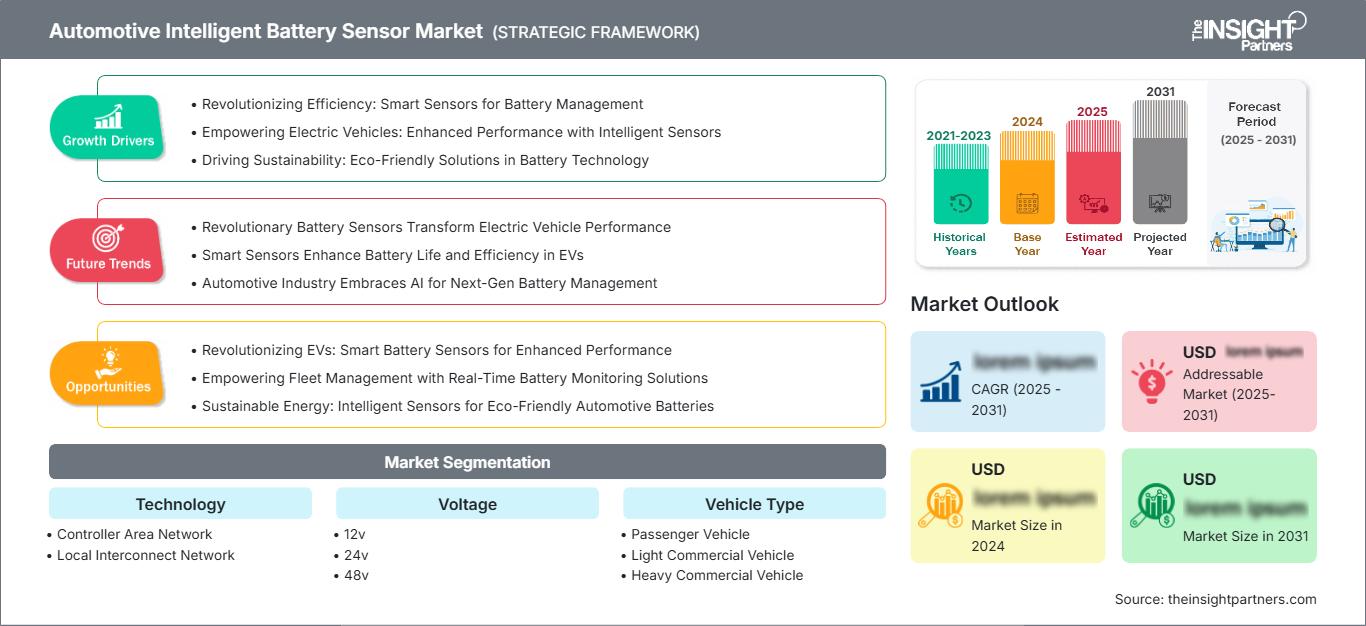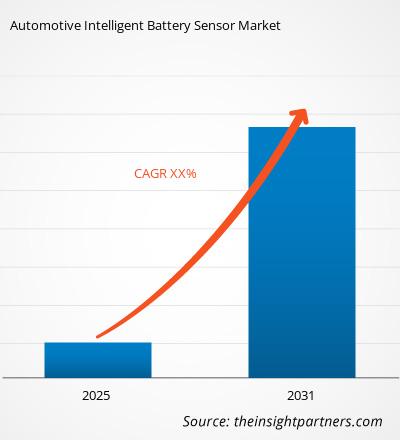Der Markt für intelligente Batteriesensoren im Automobilbereich wird bis 2031 voraussichtlich ein Volumen von 6,79 Milliarden US-Dollar erreichen. Für den Zeitraum 2025–2031 wird ein jährliches Wachstum von 9,6 % erwartet.
Der Bericht ist nach Technologie (Controller Area Network, Local Interconnect Network) kategorisiert und analysiert den Markt zudem nach Spannung (12 V, 24 V, 48 V). Er untersucht den Markt außerdem nach Fahrzeugtyp (Pkw, leichte Nutzfahrzeuge, schwere Nutzfahrzeuge) und Fahrzeugtyp (Plug-in-Hybridfahrzeuge, Hybridfahrzeuge). Für jedes dieser Schlüsselsegmente wird eine detaillierte Aufschlüsselung auf globaler, regionaler und Länderebene bereitgestellt. Der Bericht enthält Marktgrößen und Prognosen für alle Segmente, angegeben in US-Dollar. Der Bericht liefert zudem wichtige Statistiken zum aktuellen Marktstatus führender Akteure sowie Einblicke in vorherrschende Markttrends und neue Chancen.
Zweck des Berichts
Der Bericht „Automotive Intelligent Battery Sensor Market“ von The Insight Partners beschreibt die aktuelle Marktlage und das zukünftige Wachstum, die wichtigsten Treiber, Herausforderungen und Chancen. Er bietet Einblicke für verschiedene Akteure im Markt, darunter:
- Technologieanbieter/Hersteller: Um die sich entwickelnde Marktdynamik zu verstehen und potenzielle Wachstumschancen zu erkennen, können sie fundierte strategische Entscheidungen treffen.
- Investoren: Um eine umfassende Trendanalyse hinsichtlich Marktwachstumsrate, Finanzprognosen und Chancen entlang der Wertschöpfungskette durchzuführen.
- Regulierungsbehörden: Um Richtlinien zu regulieren und Aktivitäten auf dem Markt zu überwachen, mit dem Ziel, Missbrauch zu minimieren, das Vertrauen der Investoren zu wahren und die Integrität und Stabilität des Marktes zu gewährleisten.
Marktsegmentierungstechnologie für intelligente Batteriesensoren in der Automobilindustrie
- Controller Area Network
- Local Interconnect Network
Spannung
- 12 V
- 24 V
- 48 V
Fahrzeugtyp
- Pkw
- Leichter Nutzfahrzeug
- Schwerer Nutzfahrzeug
Elektrofahrzeug
- Plug-in-Hybridfahrzeug
- Hybridfahrzeug
Sie erhalten kostenlos Anpassungen an jedem Bericht, einschließlich Teilen dieses Berichts oder einer Analyse auf Länderebene, eines Excel-Datenpakets sowie tolle Angebote und Rabatte für Start-ups und Universitäten.
Markt für intelligente Batteriesensoren für Kraftfahrzeuge: Strategische Einblicke

-
Holen Sie sich die wichtigsten Markttrends aus diesem Bericht.Dieses KOSTENLOSE Beispiel umfasst Datenanalysen, die von Markttrends bis hin zu Schätzungen und Prognosen reichen.
Wachstumstreiber für intelligente Batteriesensoren im Automobilsektor
- Revolutionäre Effizienz: Intelligente Sensoren für das Batteriemanagement
- Leistungssteigerung bei Elektrofahrzeugen: Verbesserte Leistung durch intelligente Sensoren
- Nachhaltigkeit fördern: Umweltfreundliche Lösungen in der Batterietechnologie
Zukunftstrends für intelligente Batteriesensoren im Automobilsektor
- Revolutionäre Batteriesensoren verbessern die Leistung von Elektrofahrzeugen
- Intelligente Sensoren verlängern die Batterielebensdauer und erhöhen die Effizienz von Elektrofahrzeugen
- Die Automobilindustrie setzt auf KI für das Batteriemanagement der nächsten Generation
Marktchancen für intelligente Batteriesensoren im Automobilsektor
- Revolutionäre Elektrofahrzeuge: Intelligente Batteriesensoren für verbesserte Leistung
- Optimiertes Flottenmanagement mit Echtzeit-Batterieüberwachungslösungen
- Nachhaltige Energie: Intelligente Sensoren für umweltfreundliche Automobile Batterien
Markt für intelligente Batteriesensoren im Automobilbereich
Die regionalen Trends und Einflussfaktoren auf den Markt für intelligente Batteriesensoren in der Automobilindustrie während des gesamten Prognosezeitraums wurden von den Analysten von The Insight Partners ausführlich erläutert. Dieser Abschnitt behandelt außerdem die Marktsegmente und die geografische Verteilung des Marktes für das Management von Herzrhythmusstörungen in Nordamerika, Europa, dem asiatisch-pazifischen Raum, dem Nahen Osten und Afrika sowie Süd- und Mittelamerika.
Berichtsumfang zum Markt für intelligente Batteriesensoren in der Automobilindustrie
| Berichtsattribut | Einzelheiten |
|---|---|
| Marktgröße in 2024 | US$ XX Billion |
| Marktgröße nach 2031 | US$ 6.79 Billion |
| Globale CAGR (2025 - 2031) | 9.6% |
| Historische Daten | 2021-2023 |
| Prognosezeitraum | 2025-2031 |
| Abgedeckte Segmente |
By Technologie
|
| Abgedeckte Regionen und Länder |
Nordamerika
|
| Marktführer und wichtige Unternehmensprofile |
|
Marktdichte intelligenter Batteriesensoren für die Automobilindustrie: Auswirkungen auf die Geschäftsdynamik
Der Markt für intelligente Batteriesensoren in der Automobilindustrie wächst rasant. Treiber dieser Entwicklung ist die steigende Nachfrage der Endverbraucher, die auf Faktoren wie sich wandelnde Verbraucherpräferenzen, technologische Fortschritte und ein wachsendes Bewusstsein für die Vorteile des Produkts zurückzuführen ist. Mit steigender Nachfrage erweitern Unternehmen ihr Angebot, entwickeln innovative Lösungen, um den Kundenbedürfnissen gerecht zu werden, und nutzen neue Trends, was das Marktwachstum zusätzlich ankurbelt.

- Holen Sie sich die Markt für intelligente Batteriesensoren für Kraftfahrzeuge Übersicht der wichtigsten Akteure
Wichtigste Verkaufsargumente
- Umfassende Abdeckung: Der Bericht bietet eine umfassende Analyse der Produkte, Dienstleistungen, Typen und Endnutzer des Marktes für intelligente Batteriesensoren in der Automobilindustrie und vermittelt so ein ganzheitliches Bild.
- Expertenanalyse: Der Bericht basiert auf dem fundierten Wissen von Branchenexperten und Analysten.
- Aktuelle Informationen: Der Bericht gewährleistet Geschäftsrelevanz durch die Berücksichtigung aktueller Informationen und Datentrends.
- Anpassungsmöglichkeiten: Dieser Bericht kann an spezifische Kundenanforderungen angepasst werden und sich optimal in die Geschäftsstrategien integrieren.
Der Forschungsbericht zum Markt für intelligente Batteriesensoren in der Automobilindustrie kann somit maßgeblich dazu beitragen, das Branchenszenario und die Wachstumsaussichten zu entschlüsseln und zu verstehen. Auch wenn einige berechtigte Bedenken bestehen, überwiegen die Vorteile dieses Berichts insgesamt die Nachteile.
- Historische Analyse (2 Jahre), Basisjahr, Prognose (7 Jahre) mit CAGR
- PEST- und SWOT-Analyse
- Marktgröße Wert/Volumen – Global, Regional, Land
- Branchen- und Wettbewerbslandschaft
- Excel-Datensatz
Aktuelle Berichte
Verwandte Berichte
Erfahrungsberichte
Grund zum Kauf
- Fundierte Entscheidungsfindung
- Marktdynamik verstehen
- Wettbewerbsanalyse
- Kundeneinblicke
- Marktprognosen
- Risikominimierung
- Strategische Planung
- Investitionsbegründung
- Identifizierung neuer Märkte
- Verbesserung von Marketingstrategien
- Steigerung der Betriebseffizienz
- Anpassung an regulatorische Trends






















 Kostenlose Probe anfordern für - Markt für intelligente Batteriesensoren für Kraftfahrzeuge
Kostenlose Probe anfordern für - Markt für intelligente Batteriesensoren für Kraftfahrzeuge